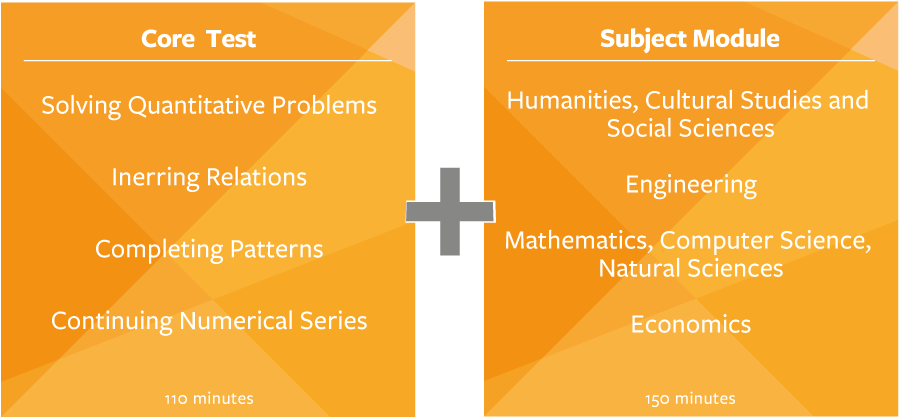
Structure of the paper-based TestAS
Examination in German or English
The paper-based TestAS is conducted in German and English at licensed test centres of g.a.s.t. You choose the language in which you feel most comfortable. Only a few universities require TestAS to be taken in a specific language. Please check the universities' websites for more information.
Core Test and Subject Module
In the Core Test, you will work on four different groups of tasks in 110 minutes, with 22 tasks in each group: Solving quantitative problems (45 minutes), Inferring Relations (10 minutes), Completing Patterns (20 minutes + 5 minutes of reading for instructions) and Continuing Numerical Series (25 minutes + 5 minutes of reading for instructions).
In the Subject Module, you will work on two or three groups of tasks in about 150 minutes, depending on the module.

1. Solving Quantitative Problems
This group of tasks tests your numerical thinking and your ability to solve mathematical problems. You will be presented with practice-related text tasks that you have to solve using elementary arithmetic operations.
2. Inferring Relations
These tasks test logical and analytical thinking. Each question consists of two pairs of words. Two of the four words are missing, and you are to identify the matching words so that both pairs of words have an analogous relationship. This involves logical thinking in the linguistic area. You recognise meanings, generalise and abstract to form rules, and substantiate these to supplement the missing terms.
3. Completing Patterns
This group of tasks measures the ability to recognise and complete visual patterns and structures. The tasks include identifying shapes, continuing patterns and recognising symmetries and transformations without any prior linguistic or technical knowledge. Your task is to fill in the missing geometric figure in the last field.
4. Continuing Numerical Series
This part tests the ability to recognise and continue numerical patterns. The tasks include identifying patterns in number sequences and predicting the next elements in the sequence. Knowledge of the four basic arithmetic operations – addition, subtraction, multiplication and division – is sufficient to solve the tasks.
Humanities, Cultural Studies and Social Sciences
This group of tasks focuses on reading and understanding short texts. To answer the questions correctly, you need to analyse the text content, identify main ideas and draw conclusions. It is important to grasp the context and the author's intentions, as well as to recognise different possibilities for interpretation.
This tests your ability to think inductively and to transfer abstract ideas into concrete ones and vice versa. You have to interpret information presented in graphical form and transfer it into a verbal form.
These items test your understanding of linguistic structures and grammar. Based on short sentences in a fictitious language and their English/German ‘translations’, you are to deduce the meaning of words, semantic relations and grammatical rules. With this knowledge, you are then to ‘translate’ new sentences into the fictitious language. This item type tests your ability to recognise and apply linguistic patterns and rules to new situations.
Engineering
This group of tasks tests your ability to formalise, your reasoning and combinative thinking, and your ability to work with basic mathematics. You have to express technical and scientific facts in formulas and relate quantities.
This is about interpreting and understanding spatial representations. You have to infer from one view of a body to other perspectives of the same body.
These tasks require an understanding and analysis of diagrams, charts or tables in which technical and scientific principles are presented in abstract form. You should be able to identify causes and effects in technical processes, think through technical problems and develop solutions. Knowledge of mathematics, physics or technology is not required here.
Mathematics, Computer Science and Natural Sciences
This group of tasks tests how well someone can visualise and analyse simple scientific facts. It also involves recognising connections, distinguishing important data from unimportant data, and drawing the right conclusions from the information presented.
In this group of items, you have to transfer information between text and graphical representations (e.g. flow chart). This item type assesses the ability to transfer scientific facts into models, to think in formalised systems, to check given facts for correctness and to apply basic scientific understanding.
Economics
This group of tasks primarily assesses the ability to distinguish important data from unimportant data and the ability to draw the right conclusions from the information presented. The participants are to analyse and interpret diagrams, charts and tables from the field of economics.
This part tests your ability to translate specific economic facts into models, analyse flowcharts and think in formalised systems. You need to think critically in the sense that you have to check given facts for accuracy.
Test preparation and procedure
After the Core Test, there is a 30-minute break outside the examination room.
In the paper-based TestAS, answers are mainly given by selecting one of several options (usually four; multiple choice format). An exception is the subgroup ‘Continuing Numerical Series’.
Detailed descriptions of the tasks, processing instructions, sample tasks and solution descriptions can be found in our ‘sample questions’.
Prepare for the paper-based TestAS by using our practice material and learning more about the exam procedure.
Preparation for the paper-based TestAS
